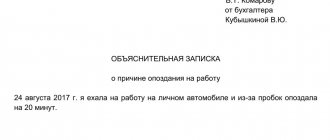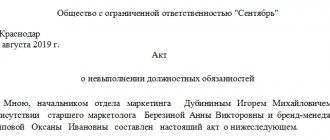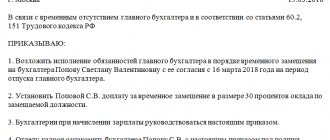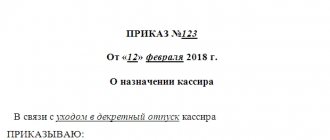- comment;
- rebuke;
- dismissal for appropriate reasons.
The application of disciplinary sanctions not provided for by federal laws, charters and regulations on discipline is not allowed (Part 4 of Article 192 of the Labor Code of the Russian Federation). These documents provide, in addition to those listed, other disciplinary sanctions for certain categories of employees. For example, in accordance with the Regulations on the discipline of railway transport workers, the employer can deprive the driver of the right to drive a locomotive and other rolling stock (clause 15 of the Regulations on the discipline of railway transport workers of the Russian Federation, approved by Decree of the Government of the Russian Federation on August 25, 1992 No. 621).
When imposing a disciplinary sanction, it is necessary to comply with the time limits established by the Labor Code of the Russian Federation. It is applied no later than one month from the date of discovery of the misconduct, not counting the time of illness of the employee, his stay on vacation, as well as the time required to obtain the opinion of the trade union body (if it is created in the organization). For example, if an employee was late for work on March 12, and this became known only on April 16, he cannot be punished.
It is also necessary to know that disciplinary sanction cannot be applied later than six months from the date of commission of the offense, and based on the results of an audit or audit of financial and economic activities, it can be applied no later than two years from the date of its commission. These time limits do not include the time of criminal proceedings. This is about collecting evidence. If six months have passed since the commission of the offense, and the evidence has not been fully collected, the employee cannot be punished.
For each offense, only one penalty can be applied (clauses 3, 4 and 5 of Article 193 of the Labor Code of the Russian Federation).
The employee has the right to appeal a disciplinary sanction to state labor inspectorates and (or) bodies for considering individual labor disputes (Part 7 of Article 193 of the Labor Code of the Russian Federation).
A disciplinary sanction is formalized by order. The following documents are required for its publication:
- explanatory letter;
- memo;
- act (drawn up if the employee refuses to write an explanatory note).
Expert of the National Union of Personnel Officers Stella Ardatova comments:
There are certain requirements for the preparation of organizational and administrative documentation, which includes explanatory and memos. They are established by GOST R 6.30–2003 “Unified documentation systems. Unified system of organizational and administrative documentation. Documentation requirements." If the organization has standard forms of documents for different cases, approved by local regulations, it is necessary to draw up these documents according to the forms approved by the organization.
An explanatory note is drawn up by an employee at the request of the employer, in which the offender provides in writing a reasoned explanation of the reasons for failure to perform any work, violation of established safety rules, labor regulations, etc. In Art. 193 of the Labor Code of the Russian Federation states: before applying a disciplinary sanction, the employer must require an explanation from the employee in writing. The explanatory note can be either written by hand or printed. It is written in the name of the manager and signed by the author (see example 1).
If the employee refuses to write an explanatory note, then, according to Part 2 of Art. 193 of the Labor Code of the Russian Federation, this is not an obstacle to imposing a disciplinary sanction.
The report is drawn up by the head of the structural unit based on the employee’s explanatory note. In addition to the actual text of the document, it indicates the name of the structural unit where its author works, the name of the type of document, the title, the person to whom the memorandum is addressed, and the date of preparation. The registration index is set if the memos are registered as internal documents. The author signs the memorandum.
Organizations also draw up memos. Currently, they are considered as an analogue of reports - only the name of the type of document changes, but the rules of execution remain the same (see example 2).
If an employee refuses to write an explanatory note, a report about this is drawn up. This document is in free form. It is signed by the organization’s employees who were present at the time of refusal. It is desirable that there be at least three of them (see example 3).
If the listed documents are available, the personnel service prepares a draft order for disciplinary action. The form of such an order has never been unified. In practice, it is drawn up in the form of an order for the main activity or according to the rules for drawing up unified forms of personnel orders.
Orders for core activities are issued on the organization’s general letterhead. Their text consists of a stating and an administrative part, which are separated by the verb “I order” (see example 4).
In the second case, the text of the order on disciplinary action begins with a verb, and it contains the attribute “ground” (see example 5).
It is preferable to use the second option, since this design differs from orders for the main activity and is closer to the design of orders related to primary labor accounting documents.
Penalties are announced to the employee against receipt within 3 days from the date of issue of the order. If the employee refuses to sign the order, a report is drawn up. It is drawn up in any form, in accordance with Part 6 of Art. 193 Labor Code of the Russian Federation.
The employer in accordance with Art. 194 of the Labor Code of the Russian Federation has the right, before the expiration of a year from the date of application of a disciplinary sanction, to remove it from an employee on his own initiative, at the request of the employee, at the request of the head of a structural unit or trade union body. The removal of a disciplinary sanction is also formalized by order.
It must be remembered that neither the order to impose a disciplinary sanction nor the order to remove the disciplinary sanction are entered into the work record book.
Example 1
Major operational disturbances
The following offenses may be grounds for writing a document::
- an employee being late for work, resulting in a disruption in the production process, financial losses or customer complaints;
- absence from work without warning and without a good reason (you can see how to write a memo for time off here, and here you can see how to write a memo about an employee’s absence from the workplace);
- being at the workplace drunk or in a state of toxic or narcotic intoxication;
- non-compliance with safety regulations, as a result of which there was an accident at work, an emergency situation (or something similar could happen with a high degree of probability);
- theft, damage or destruction of company property, regardless of the amount of losses incurred;
- violation of the obligation to maintain commercial or state secrets, personal data of enterprise employees and other types of information that are not subject to disclosure under the terms of the contract.
The memo must indicate what violation the employee committed and provide the necessary evidence.
Read more about what a memo is and how this document is drawn up according to GOST in a separate article.
Letter of reprimand sample 2021
Thus, the technical support specialist Yu G exceeded his official authority, and, not being a specialist in infrastructure systems, in particular the MS Exchange server, without coordinating his actions with either management or the technical support specialist on duty, he performed actions with the server that resulted in prolonged outage of email exchange service for two thirds of all users.
Sukharevsky Memo on the employee’s failure to fulfill his job duties This document is intended to convey to management information that the employee has improperly performed or has not performed his professional duties at all. The final document contains a request for disciplinary action.
There are three different samples of memos for an employee to choose from. Legislative framework The legislation does not distinguish certain types of official information, therefore
Who should write the document?
A memo on disciplinary action is written by the manager to his immediate subordinates if they do not perform their duties properly. Who exactly will write depends on what kind of violation occurred.
For example, timekeepers or personnel department employees monitor timely attendance at work . Compliance with the regime is monitored by the heads of structural units, to whom employees turn when there is a need to leave the workplace or report illness. If, for example, any task was not completed on time, a memo about violation of the deadlines for work under the contract can be drawn up by the manager who controls the deadlines.
A memo on the imposition of a disciplinary sanction is, as a rule, prepared by an inspector of the HR department, and on the removal of a sanction - by the head of a structural unit, who directly monitors how the employee continues to work after receiving a sanction.
What points does it consist of?
There is no single template for writing memos, so they are compiled in any form. Rules to follow :
- indication of the addressee;
- Title of the document;
- date and serial number;
- subject of the note;
- the main part provides a description of the situation and formulates the request (and/or the intentions of the department head regarding the offending employee);
- Below is the position of the compiler, his signature and its transcript, and, if necessary, full name, first name, first name, and signatures of other team members who can confirm the fact described in the document.
The “header” can be placed in the center of the document or attached to its edge.
Since the note is a tool for business correspondence, it should be written in an informational and business style.
The problematic situation is described without unnecessary words and complex speech patterns: concisely, succinctly and to the point. The service note is registered in a special journal . The journal is usually located in the secretariat.
Read more about the rules for preparing official memos in accordance with GOST, as well as what requirements apply to their writing here.
Sample memo on failure to fulfill official duties
If a fact of non-fulfillment or insufficient conscientious fulfillment of official duties is discovered, the responsible persons have the right to draw up an official memorandum in accordance with the model adopted in the given company. Find out how to properly draw up such a document, what you need to pay attention to, and ready-made examples of notes in this article.
Purpose and types
During work, each employee can record the fact of failure to fulfill official duties by his colleague (or several colleagues) and initiate (as well as write independently) the preparation of a corresponding memorandum according to a certain sample or in any form.
The main purpose of such a measure is to record the actual fact of violation of internal regulations, for example:
- being late without a good reason;
- premature departure from work;
- absenteeism;
- appearing drunk;
- incorrect performance of one's duties;
- inaction resulting in consequences for the company and/or other employees;
- incorrect communication with colleagues, etc.
Can be used both inside and outside the enterprise. Therefore, they are divided into 2 types:
- Internal is the most common option when you need to convey the fact of incorrect work to a higher-ranking employee. Typically, the paper is drawn up on the company's letterhead, in accordance with the instructions provided by the enterprise (if any). To certify the document, it is enough to put only the signatures of the employees who witnessed the incident.
- External - in this case it is drawn up in the name of representatives of regulatory authorities or in the name of the head of the central office (i.e. the document goes outside the company). Such a paper can be drawn up in connection with incorrect actions of the manager, which employees report to a higher authority. This document must be certified by signatures and the seal of the organization.
In form, these papers are practically no different. The main thing is to take care of the evidence base, be ready to defend your point of view, and also take into account several mandatory requirements for drafting, which are discussed below.
How to compose
As a rule, the company has its own templates and rules for drawing up reports when it is necessary to record the fact of non-fulfillment of official duties by a particular employee. Therefore, the form and content of the document are arbitrary. Usually the following drafting rules are followed:
- First of all, a “header” is drawn up, in which the full name of the director (or other responsible person) in whose name the paper is written is written. The short name of the company is also indicated.
- Then the name of the document and number are written down (usually in chronological order, which needs to be clarified in the document flow log).
- Next, you need to briefly but succinctly state the essence of the comment. Describes a fact, an incident that indicates incorrect performance of official duty, unprofessional actions or inaction. For example, late submission of reports, incorrect completion of documentation, lateness, incorrect communication with colleagues, etc.
- After this, you can justify the violation by qualifying it accordingly - for example, according to labor legislation (absenteeism, appearing in a state of intoxication) or in accordance with the internal regulations of the organization (for example, failure to comply with a professional standard when serving a customer at the checkout).
- If such actions (or inaction) entailed certain sanctions against the company, this fact must be described in detail. For example, “as a result of the inaction of employee Ivanov N.K. a fine of 10,000 rubles was imposed on the company by the tax inspectorate.”
- Next, the drafters of the paper must clearly state their request, starting the sentence with the word “I propose...”. Typically, certain disciplinary actions are proposed - for example, a reprimand, depreciation or even dismissal.
- Next, each person who participated in the drafting of the text (and was also a direct witness to the incident) puts his signature, and also writes down his last name, initials and the full name of the position he currently holds.
Considerations of business ethics exclude the description of any subjective opinions in the note. It is important to understand that the document specifically records the fact of violation of labor discipline, non-compliance with duties, therefore the text should reflect only the incident itself and propose a measure of responsibility in relation to the unscrupulous employee.
Who applies to whom?
There is no specific unified regulation. However, each company has its own procedure - both in written and oral form: usually all memos are submitted to:
- general director;
- his deputy;
- head of the branch;
- foreman
In this case, such a document is submitted either by senior employees or those at the same level - that is, precisely those who have registered the fact of insufficiently conscientious performance of duties.
Every person in the company has the right to write a note to any employee, regardless of his specific position.
That is, theoretically, an ordinary employee can write a complaint to the general director against his immediate supervisor.
In practice, every company has an unspoken order and its own hierarchy, but in principle all people have the opportunity to complain.
Registration procedure
In different organizations, the procedure for recording facts of violation of labor discipline and written confirmation may be different, but in general the sequence of actions is as follows:
- The fact of violation of discipline, dishonest performance or complete failure to fulfill duties is recorded. You can use audio and video recording equipment, and involve other workers as witnesses.
- The text of the note is compiled.
- The paper is certified by the responsible person - as a rule, this is a senior salesman, shift supervisor, foreman, HR manager and other employees.
- Then the paper is submitted directly to the manager in whose name it was drawn up.
- The manager considers the appeal on its merits, takes action and issues his own order (order) or rejects the appeal, if necessary, explaining the reasons for the refusal to the employees who issued it.
Sample and examples
In general, you can use the following form as a basis:
Below we consider several examples of memos that can be taken as a sample if it is necessary to record the fact of an employee’s failure to fulfill his official duties.
Types of disciplinary sanctions
At the moment, all penalties that can be applied to an employee come down to 3 types:
- Written comment.
- Drawing up a reprimand.
- Involuntary dismissal due to insufficient work performance.
At the same time, the Labor Code states that no other types of penalties are allowed. Management can choose any of these measures, and in some cases we are immediately talking about issuing a reprimand or even dismissal, so the employer is not obliged to follow the given sequence.
However, the order of application of the measure must be taken into account - in general it consists of the following actions:
- The fact of failure to fulfill official duties is recorded, as a result of which a report can be drawn up according to the established template. Drawing up this paper is the right, but not the obligation of the employer.
- The employee must be required to draw up an explanatory note - i.e. a written explanation of the reasons for his action (or inaction).
- If he refuses to comply with this requirement, an appropriate act must be drawn up, which is signed by witnesses (colleagues).
- Next, a measure is implemented that is supposed to be responsible for the action - a remark is recorded, a reprimand is issued, or the employee is immediately forcibly dismissed.
A violation can be recorded within a maximum of 6 months from the day it was committed by the employee. That is, if an incident is discovered after this period, it will be impossible to initiate a disciplinary procedure. Although going to court cannot be ruled out.
More details about disciplinary actions can be seen here.
Reprimand: instructions for drawing up
After a failure to fulfill official duties has been noted, about which a report has been drawn up according to the appropriate sample, employers most often take two measures - a reprimand or a reprimand. It is important to understand that only one measure is applied for one offense.
As a rule, management makes a decision on a reprimand, which is communicated in a written order (order). At the same time, neither the form of the reprimand nor the form of this order is established, therefore each company has the right to use its own forms and samples. Typically the document contains the following sections:
- Date, place of drawing up the order, full official name of the organization.
- The name and number of the order in accordance with accepted document flow rules (usually in chronological order).
- Actually a statement of the contents of the order. Information about the employee is provided (full name, position, personnel number if available, other essential information) and the reason for the reprimand. Links to regulatory documents are described - labor legislation, internal regulations, as well as evidentiary papers (for example, a memorandum).
- Applications are described - that is, documents that are attached to the order indicating the quantity and type (copy or original).
- A stamp, signature of the director and transcript (last name, initials) are affixed.
A sample order is presented below:
NOTE. The order must always be signed by the employee - it is assumed that by these actions he confirms the fact that he has read the text, but this does not mean that he agrees with the content. If an employee refuses to sign, a corresponding act of refusal is drawn up, which is signed by other employees of the organization who attest to this fact.
link:
(1 5,00 of 5) Loading...
Source: https://2ann.ru/disciplinarnoe-vzyskanie-za-neispolnenie-dolzhnostnyx-obyazannostej/
Writing Instructions
Disciplinary action may be imposed for a number of reasons. How to correctly write a document about disciplinary action?
Violation of labor discipline
A document on violation of labor discipline confirms the fact of violation:
- internal regulations;
- rules of the organization;
- norms of the Law.
He informs his superiors that any of the employees are irresponsible in their work.
Failure to comply with these points may be partial or complete, intentional or unintentional, which must be taken into account when drawing up a memo.
Approximate compilation algorithm:
- name and position of the responsible person;
- in the first line - the main heading “Official memo”, in the second line - the subheading “about violation by an employee (full name and position) of labor discipline” or “about failure (full name and position) of official duties" ;
- main part: description of all facts indicating a violation (if there are several of them, it is advisable to divide the text into paragraphs);
- ending: contains suggestions regarding penalties that can be applied to a negligent employee;
- at the bottom of the document is the current date of writing, full name. and the signature of the official who compiled the document.
The basis for the penalty may be a memorandum, an act of violation, or a decision of the commission on the employee’s involvement in causing damage to the employer.
You can find out how to properly prepare a memo, as well as see a sample document, here.
About disciplinary action
An official letter about the imposition of a penalty is drawn up after recording the fact of violation of labor discipline, taking into account the previous official memo, as well as the explanatory note received from the employee who committed the misconduct. The document indicates to whom, for what and on what basis the penalty was imposed.
Approximate compilation algorithm:
- the name and position of that person. to whom it is addressed;
- the heading “Official memo” and the subheading “on the imposition of penalties” (full name and position of the employee who violated the employment contract) in the genitive case;
- the basis for drawing up a note (act, report, commission decision on the employee’s involvement in causing damage to the employer in a brief summary) indicating the clause of the employment contract that was violated;
- how the employee will be punished;
- date of writing, full name and signature of the official.
About its removal
Very often, an employee who has received a penalty, but values his work, no longer commits similar violations and works well. In this case, the immediate supervisor may change his decision and draw up a memo requesting higher management to lift the disciplinary sanction from the offending employee.
A note on the lifting of a disciplinary sanction is written arbitrarily in the name of the main manager of the organization who imposed it on the employee.
Approximate compilation algorithm:
- name and position of the person. the head of the organization;
- the name and position of the head of the department composing the note;
- document's name;
- reference to the order of disciplinary action with a date;
- arguments in favor of the employee and reasons for canceling the penalty;
- final request to interrupt the collection ahead of schedule;
- date of preparation of the official document and signature with transcript.
Sample memo on disciplinary sanctions and failure to fulfill duties
The purpose of the note is to convey to the addressee a request to apply sanctions to the violator. It must indicate facts reflecting the employee’s inappropriate behavior and/or failure to fulfill his direct official duties.
In this article we will look at the main nuances of designing this type of memo.
Dear readers! Our articles talk about typical ways to resolve legal issues, but each case is unique.
If you want to find out how to solve your particular problem, contact the online consultant on the right or call the free consultation numbers:
Who writes a memo about failure to fulfill duties and when?
A memo is written by a boss to his subordinate when the latter fails to fulfill his official duties. Initially, any employee must familiarize themselves with these requirements and then sign an employment contract as a sign of their agreement with them.
An official or otherwise memo about failure to fulfill official duties is an element of a company’s internal business correspondence, which is an information document.
Having assumed a position, the employee is obliged to follow the instructions of his superiors , if they do not go beyond the previously agreed upon job responsibilities. Otherwise, the manager has the right to draw up a memo about failure to fulfill duties addressed to his superiors.
Types, specific features and samples
Disciplinary action may be imposed on an employee for several reasons. Accordingly, for each case the memo will have its own writing nuances.
Let's consider these features for the main violations committed by employees while working in a particular company.
Failure to fulfill official duties
as described above, this element of internal business correspondence is drawn up in the event that an employee does not follow the direct instructions of his boss . despite the fact that the order given to him falls within the area of his responsibility.
The header of the document indicates the addressee and his position in the company. then follows a heading in which you will need to write down not only the phrase “official memo”, but also add a second heading - “about the failure of the employee (name and position) to fulfill official duties.”
Read about in what cases it is necessary to write an explanatory note here.
Next comes the main part of the document, where all the facts indicating a violation . If the text is large enough, it is better to divide it into paragraphs. at the end, proposals are made for penalties that should be applied to the offending employee.
The document should be marked with the current date of writing and a signature with a transcript.
notes on failure to fulfill obligations under the link.
about being late for work
Being late for work is a phenomenon that every manager of any company has had to deal with. The manager of the late employee decides whether a verbal warning , or whether the best solution would be to draw up a memo about being late for work.
the drafter of the document sets out the problem in the main text and asks to apply disciplinary sanctions for being late.
but if the reason for the employee’s lateness is quite valid, and there is official confirmation , his boss can take this circumstance into account, indicate it in the memo and offer to minimize or not impose penalties for the violation at all.
memo about being late.
about absence from work
Absence from work is one of the gross violations of discipline . in this case, the supervisor of the employee who is skipping work will need to draw up a report on the employee’s absence from the workplace, as well as draw up a memo to senior management.
In addition to these documents, an explanatory note from the employee who was absent from work is attached.
in the main text of the official letter you will need to indicate the date of absence, the period of absence, and how the violation affected the production process. at the end, proposals are made for disciplinary sanctions for the offending employee.
sample report on truancy: download here.
about violation of labor discipline
This concept can be called a violation of the internal regulations and rules of the organization , legal norms. this can be either non-compliance or partial non-compliance with these points, both intentionally and unintentionally.
however, it should be remembered that if the violation did not depend on the will of the employee himself, but was caused by third-party factors, one cannot speak of a violation of labor discipline.
The most striking examples of violations of labor discipline are:
- being at work in a state of toxic, narcotic or alcoholic intoxication;
- violation of safety rules, as a result of which an industrial accident, accident, etc. occurred, or there was a high probability of such situations occurring;
- theft, damage or destruction of property in the workplace, regardless of size;
- disclosure of commercial or state secrets, personal data of employees and other information, the disclosure of which is prohibited by the terms of the contract;
- other violations specified by law.
the memo is drawn up according to the basic scheme. it will need to indicate what violation the employee committed and provide evidence , if available. and indicate the employee's preferred disciplinary action.
You can use this link to report violations of discipline.
How to write a report on the removal of a disciplinary sanction?
A business letter indicating dereliction of duty conveys a request for disciplinary action.
If the resolution of senior management is positive, the employee receives a punishment, which is prescribed in order to prevent the possibility of repeated situations of a similar nature.
But in some cases, the offending employee understands and admits that he was wrong, as a result of which he corrects himself and tries to prevent such troubles in the future.
And sometimes he even tries to rehabilitate himself in the eyes of the company and put more effort into doing his job.
If you are not satisfied with your workplace, read the article on how to resign of your own free will during a probationary period.
In the above situations, the decision of the immediate superior of the offending employee may change, and then he draws up a memo in which he asks for the disciplinary sanction to be lifted ahead of schedule .
It is written in any form in the name of the main manager of the company, who previously imposed a penalty on the offender.
The document is drawn up by the employee’s immediate supervisor, who can monitor his activities.
The letter is drawn up either manually or on a computer and contains the following data :
- name and position of the manager, name of the organization;
- the name and position of the author of the memo;
- title of the official paper;
- a link where you can track the order imposing a disciplinary sanction, the date the order was written;
- facts confirming the employee’s success in the workplace and the reasons for canceling the punishment;
- final request to terminate collection ahead of schedule;
- date of writing the note and signature.
An example of a memo on the removal of disciplinary sanctions against an employee: .
Not a single team can manage without violations of discipline on the part of employees. Therefore, it will be useful for employees in management positions at different levels to know the rules for writing appropriate memos in their company.
For example, one organization allows a document to be drawn up completely in free form, while another already has its own ready-made template used for internal business correspondence. Information about the approved structure of documents must be reflected in the internal acts of the organization.
To fully understand this topic, watch the video about disciplinary sanctions in case of failure to fulfill duties by an employee:
Source: https://bizakon.ru/kadry/obrazets-sluzhebnoj-zapiski-o-nevypolnenii-obyazannostej.html










